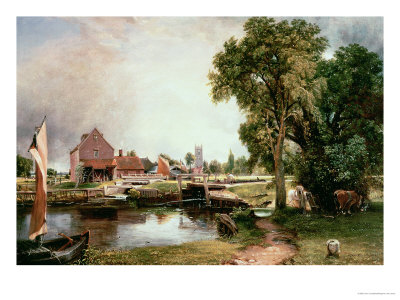For many of us today when we think of the English countryside it is the landscape paintings of John Constable that inspire the images that spring to mind.
Dedham Lock and Mill of 1820 is one such painting depicting a calm and idyllic scene of English country life at the beginning of the nineteenth century.
In this painting Constable has portrayed the landscape he loved, the landscape and the community he grew up in. He said: “Painting is but another word for feeling, and I associate my ‘careless boyhood’ with all that lies on the banks of the Stour; these scenes made me a painter”.
The main building in this scene, to the left of the centre of the composition, is the mill itself with its large waterwheel clearly visible. Constable had worked in the mill when he was young as it was owned and run by his father. To its right and in the centre of both the composition and the community it served is the tower of the local church. In the foreground is the River Stour with the lock on the far bank and a boat moored on the near bank. The right hand side of the composition is dominated by large trees beneath which two tethered horses are grazing.
The only people visible in this view are the two figures standing in front of the mill and the lone figure operating the lock to the right of the church tower. What is clear is that this is a man-made, even an industrial, landscape. The mill and the lock together allow the production and movement of the flour milled from the grain produced in the fields beyond. Constable’s painting shows man harnessing and working in harmony with a divinely created nature with God’s blessing symbolised by the church at the very centre of the image.
Looking at this painting today, it is easy to forget how much Constable’s approach to painting landscapes challenged the conventions of his time. Those conventions were very much influenced by the work of the seventeenth century French artist Claude Lorrain whose stylised Italian landscapes, often with classical or biblical themes, reflected a sense of peaceful serenity, what Constable himself called “the calm sunshine of the heart”.
Fashionable landscape painters of Constable’s day drew on Claude’s work to create acceptably pleasing pictures for their English customers. These might feature a strikingly impressive tree, a distant view opening out in the centre of the canvas and some classically or biblically inspired figures in the foreground. The colours used also copied Claude’s warm brown and golden tones for the foregrounds and his pale blues fading into the distance for the backgrounds.
But Constable’s approach to painting a landscape was very different. He simply wanted to paint what he saw with his own eyes. He wanted to portray the world around him as it really was rather than create paintings that showed a false, idealised version of reality. In “Dedham Lock and Mill” Constable succeeds in showing us his unique view of the English landscape he loved most.




